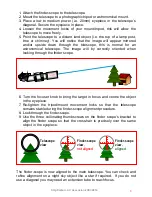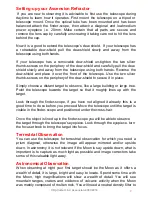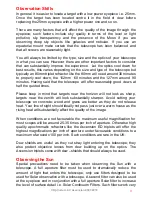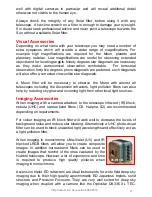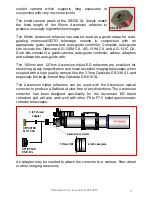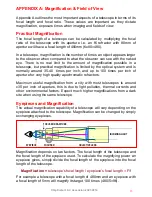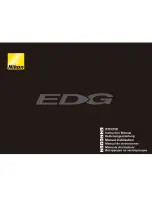
© Opticstar Ltd / Ascension 2007-2014
12
well with digital cameras in particular and will reveal additional detail
otherwise not visible to the human eye.
Always check the integrity of any Solar filter before using it with any
telescope. A hair-line scratch on a filter is enough to damage your eyesight.
If in doubt seek professional advice and never point a telescope towards the
Sun without a suitable Solar filter.
Visual Accessories
Depending on what came with your telescope you may need a number of
extra eyepieces which will provide a wider range of magnifications. For
example high magnifications are required for the Moon, planets and
planetary nebulae. Low magnifications are useful for observing extended
objects and for locating targets. Ninety degrees star diagonals are necessary
as they make astronomical observation comfortable. For terrestrial
observation forty-five degrees prism diagonals are preferred, such diagonals
will also offer a corrected view unlike star diagonals.
A Moon filter will be necessary to observe the Moon with almost all
telescopes including the Ascension refractors, light pollution filters can also
help by reducing sky glow and incoming light from other local light sources.
Imaging Accessories
When imaging with a camera attached to the telescope infra-red (IR) block,
nebula (UHC) and narrow-band filters (O3, H-alpha, S2) are recommended
depending on requirements.
For colour imaging an IR block filter will work well to decrease the levels of
background noise and reduce star bloating. Alternatively a UHC photo-visual
filter can be used to block unwanted light wavelengths and effectively act as
a light pollution filter.
When imaging in monochrome Ultra-Violet (UV) and IR
blocked LRGB filters will allow you to create composite
images. In addition narrow-band filters can be used to
create images that remind of the ones captured by the
Hubble telescope. However a lot of experience and time
is required to produce high quality pictures when
imaging in monochrome.
Ascension triplet ED refractors are ideal instruments for wide field deep-sky
imaging due to their high quality apochromatic ED Japanese triplets, solid
structure and Precision Focusers. They are very well suited for deep sky
imaging when coupled with a camera like the Opticstar DS336 XL TEC-
DS-616C XL









